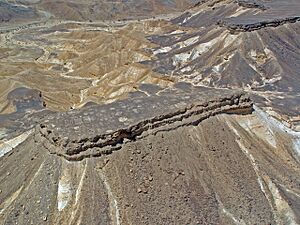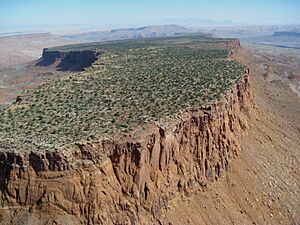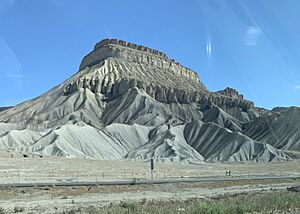Mesa facts for kids
A mesa is a special kind of hill or mountain that has a flat top and very steep sides. It looks a bit like a giant table standing alone in a flat area.
Mesas are usually made of soft sedimentary rocks at the bottom. On top, they have a harder layer of rock, like sandstone or limestone. This hard top layer is called a caprock. It protects the softer rock underneath from wearing away.
Contents
What is a Mesa?
The word "mesa" comes from the Spanish word for "table." This makes sense because mesas look like huge, flat tables rising from the ground.
Mesas are similar to buttes, but they have a much wider, flatter top. Imagine a big table (mesa) versus a small stool (butte). There isn't a strict rule for how big a mesa has to be. Some mesas, like those in Australia, can be as large as 350 square kilometers (135 square miles)! Others, like some in Germany, can be as small as 0.1 square kilometers (0.04 square miles).
In different parts of the world, mesas have other names. In Venezuela, they are called tepuis. In Australia, people might call them tablehills or jump ups.
How Mesas Form

Mesas are formed by two main processes: weathering and erosion. These processes slowly break down and carry away rock. This happens to rocks that were once flat and then pushed up by Earth's movements (called tectonic activity).
Different types of rock have different strengths. Some rocks are very hard and resist wearing away, while others are soft and erode easily. This process is called differential erosion. It means that the weaker rocks are worn away faster, leaving the stronger rocks standing tall.
The hardest rocks, like sandstone, basalt, or lava flows, often form the flat top, or caprock, of a mesa. Softer rocks, like shale, are found underneath. They erode more easily.
The different strengths of rock layers give mesas their unique shape. As softer rocks erode into valleys, the harder caprock layers are left sticking out. This caprock protects the layers below it from eroding as quickly.
The sides of a mesa often look like a staircase. This is called "cliff-and-bench topography." The hard rock layers form the steep "cliffs" or steps. The softer layers form gentler slopes, or "benches," between the cliffs.
Over time, water flowing around the mesa erodes the soft layers at the bottom. This makes the top layers unstable. Eventually, the top layers can collapse and fall away. When a mesa's caprock has mostly worn away, leaving only a small, isolated top, it becomes a butte.
Where to Find Mesas
Mesas can be found all over the world. Here are some famous examples:
Australia

- Cockburn Range, Western Australia
- Mount Conner, Northern Territory
Czech Republic
- Děčínský Sněžník
France
- Mont Aiguille, Auvergne-Rhône-Alpes
Germany
- Königstein, Saxony
- Lilienstein, Saxony
India
- Several near Owk mandal, Andhra Pradesh
Iraq
- Amadiya, Kurdistan Region
Ireland
- Kings Mountain, County Sligo
- Knocknarea, County Sligo
Israel
- Masada, Southern District
- Har Qatum
Italy
- Monte Santo, Sardinia
United Kingdom
England

- Cross Fell, Cumbria
- Higger Tor, South Yorkshire
- Ingleborough, North Yorkshire
Scotland
United States
Many mesas in the United States are found in the Basin and Range Province.
Arizona
Arkansas
California
Colorado
- Grand Mesa - This is the largest flat-topped mountain in the world!
- North Table Mountain
Nevada
Oklahoma
Texas
Utah
- Checkerboard Mesa
- Hurricane Mesa
Wisconsin
Mesas on Mars

Did you know there are mesas on Mars too? Scientists have found areas on Mars with steep-sided mesas and knobs (smaller hills). These Martian mesas are thought to have formed from ice and other processes that moved material around. They can be very tall, sometimes nearly 2 kilometers (1.2 miles) high!
See also
 In Spanish: Mesa (geomorfología) para niños
In Spanish: Mesa (geomorfología) para niños
- Butte
- Dissected plateau
- Mesa Verde National Park
- Table hill
- Table Mountain
- Tepui





